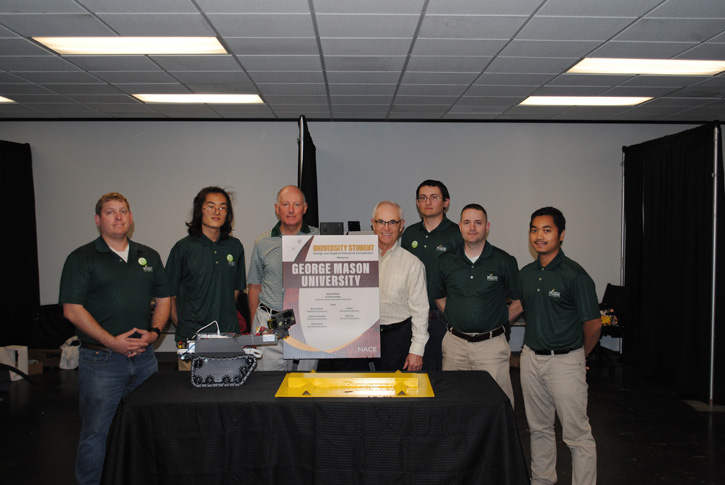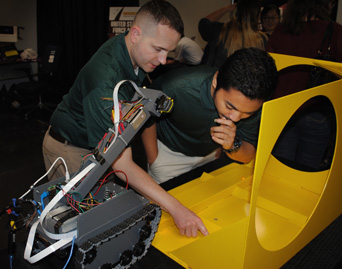
The team and advisors at the competition in April: (from left) Andy Schneider, Je Park, Robert Gallo, Dr. Patrick Moran (U.S. Naval Academy), Daniel Howe, Sonoell Clark and Pisal Yim. Not pictured: Erik Knudsen. Photo provided.
Mechanical engineering major Sonoell Clark carries a much more personal stake in the fight against corrosion than most.
The former U.S. Marine helicopter mechanic regularly dealt with corrosion when maintaining CH-46 assault helicopters while serving in austere environments aboard Navy ships and in Afghanistan.
“The nuts and bolts are made of metal,” he said, “and when they corrode, things break down. It put lives at risk in combat.”
So Clark beams with added pride when speaking of the Corrosion Detection Vehicle Design system that he and his team built as part of a capstone project in George Mason University’s Volgenau School of Engineering’s Department of Mechanical Engineering. The project gave the George Mason students real-world experience and the opportunity to better understand the impact of costly corrosion in structural components that can lead to injury or death.
“We don’t want them always sitting behind a computer,” said Mason professor of practice Robert Gallo. “We wanted them to get their hands dirty. We wanted them to physically design, build, test, break and report on a meaningful project.”
The Department of Defense’s Office of Corrosion Policy and Oversight tasked the students to design an unmanned system capable of maneuvering into hard-to-reach spaces comparable to those found on ships and aircraft, such as under antennas on ships, behind pipes, and inside fuel tanks and aircraft fuselage.
Corrosion in its various forms cost the United States $556 billion in 2016, Gallo said.
The Mason students needed to find a way to report on the size and depth of corrosion in those places and on other concerns such as moisture. Clark, along with mechanical engineering majors Daniel Howe, Andrew Schneider and Pisal Yim, and biology major Jeha Park, ultimately selected a tracked vehicle with an articulating arm and began building from scratch.
Designing the vehicle presented unique challenges for the aspiring engineers in the areas of stability, maneuverability, sensing and data transmission.

Team Leader Sonoell Clark (left) and Pisal Yim discussing detection procedures using a practice space
provided to the team at the competition. Photo provided.
Because the vehicle needed to move independently through confined metal structures, similar to what would be found aboard ships and storage tanks, and then communicate its findings to an operator some distance away, the students incorporated sensors, a computer and a camera system into the design.
The platform and articulating arm components were made on a 3-D printer. The arm was fitted with special sensors and made capable of rotating around the entire vehicle. A digital camera was installed to capture 10 megapixel still images, and a headlight was added to detect corrosion in dark spaces.
The Mason team finished third at the University Student Design and Applied Solutions Competition in Houston, Tex., that was organized by the National Association of Corrosion Engineers, trailing only the Air Force Academy and runner-up Louisiana Tech.
Gallo was equally pleased with the broader skills the students applied in accomplishing their project in the form of program management, team building, communications, scheduling, budgeting and customer interactions.
“This was about designing a mechanical system to a customer’s set of requirements,” Gallo said. “I think they all did very, very well, particularly for the first time out. The Department of Defense was equally impressed with Mason’s accomplishments.”
